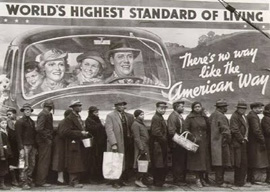
February 24, 2012

Not so. The daily consumption of proteins, vitamins and minerals of poor children is roughly the same as that of the middle class, and the poor consume more meat than the upper middle class.
Some 84 percent of America’s poor say they always have enough food to eat, while 13 percent say sometimes they do not, and less than 4 percent say they often do not have enough to eat.
Only 2.6 percent of poor children report stunted growth. Poor kids in America are, on average, an inch taller and 10 pounds heavier than the youth of the Greatest Generation that won World War II.
In fiscal year 2011, the U.S. government spent $910 billion on 70 means-tested programs, which comes to an average of $9,000 per year on every lower-income person in the United States.
Among the major programs from which the poor receive benefits are Temporary Assistance to Needy Families, the Earned Income Tax Credit, Supplemental Security Income, food stamps, the Women, Infants and Children (WIC) food program, Medicaid, public housing, low-income energy assistance and the Social Service Block Grant.
Children of the poor are educated free, K-12, and eligible for preschool Head Start, and Perkins Grants, Pell Grants and student loans for college.
Lyndon Johnson told us this was the way to build a Great Society.
Did we? Federal and state spending on social welfare is approaching $1 trillion a year, $17 trillion since the Great Society was launched, not to mention private charity. But we have witnessed a headlong descent into social decomposition.
Half of all children born to women under 30 in America now are illegitimate. Three in 10 white children are born out of wedlock, as are 53 percent of Hispanic babies and 73 percent of black babies.
Rising right along with the illegitimacy rate is the drug-use rate, the dropout rate, the crime rate and the incarceration rate.
The family, cinder block of society, is disintegrating, and along with it, society itself. Writes Rector, “The welfare system is more like a ‘safety bog’ than a safety net.”
Heritage scholars William Beach and Patrick Tyrrell put Rector’s numbers in perspective:
“Today … 67.3 million Americans—from college students to retirees to welfare beneficiaries—depend on the federal government for housing, food, income, student aid or other assistance. … The United States reached another milestone in 2010. For the first time in history, half the population pays no federal income taxes.”
The 19th century statesman John C. Calhoun warned against allowing government to divide us into “tax-payers and tax-consumers.” This, he said, “would give rise to two parties and to violent conflicts and struggles between them, to obtain the control of the government.”
We are there, Mr. Calhoun, we are there.